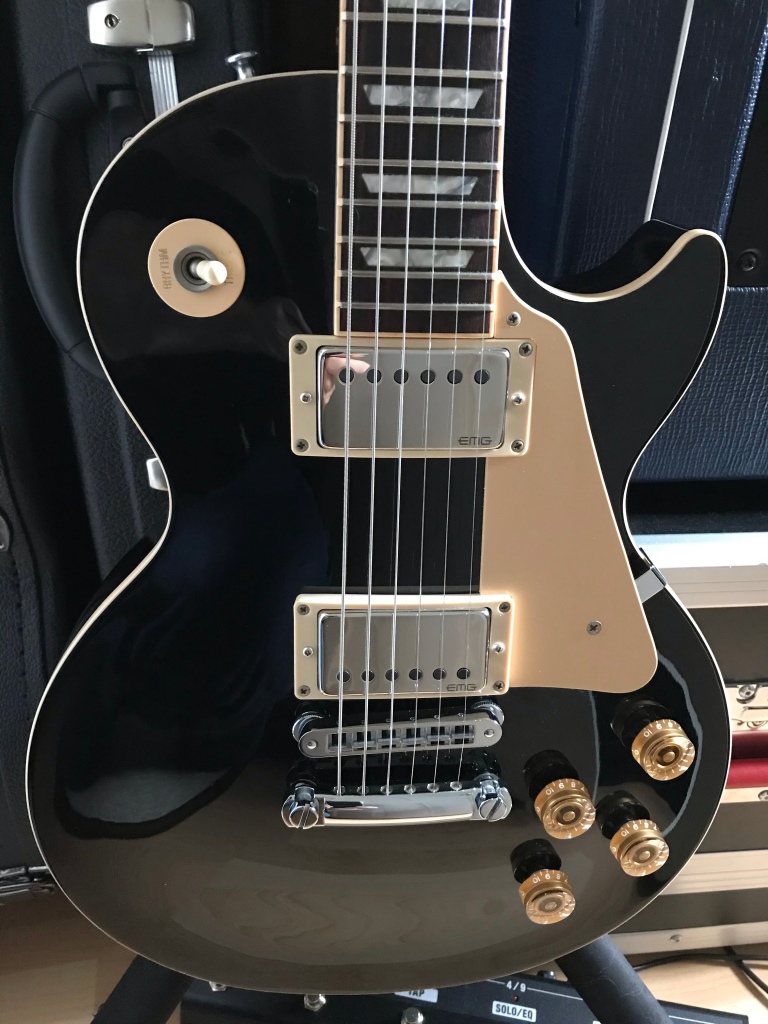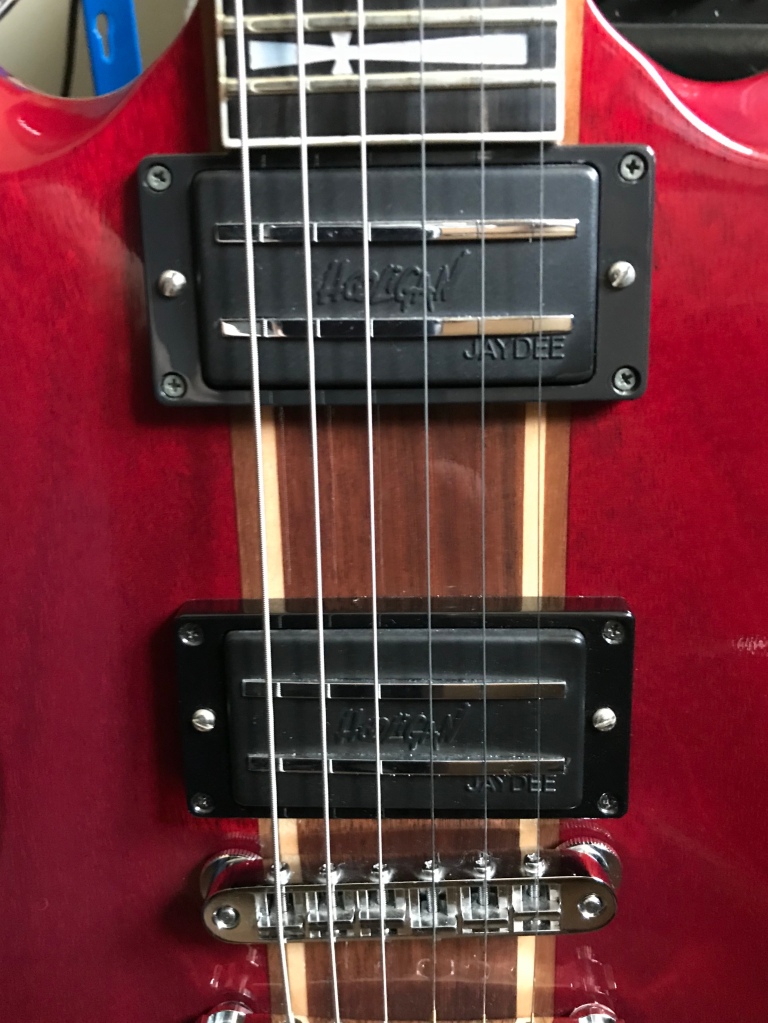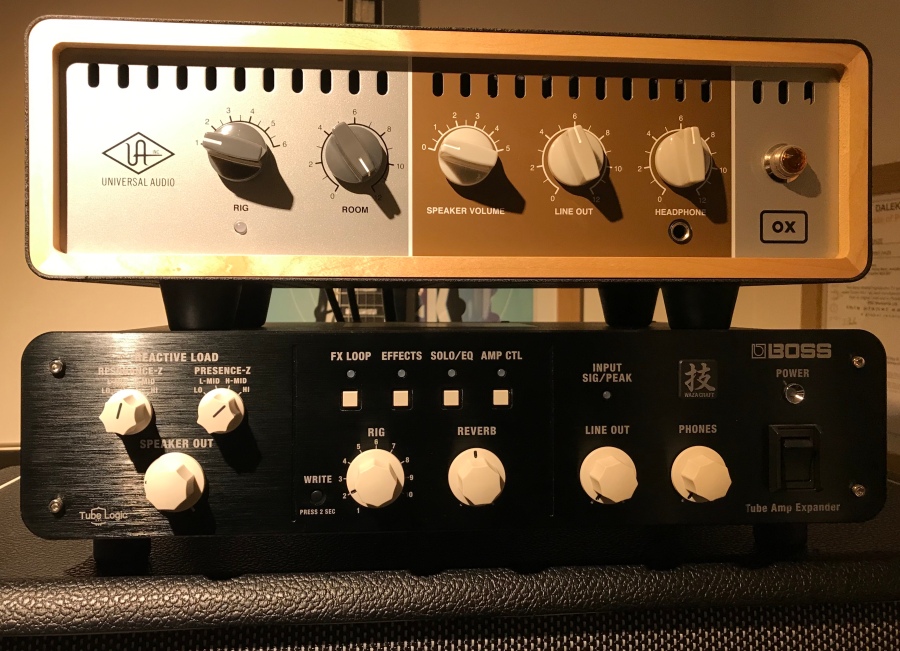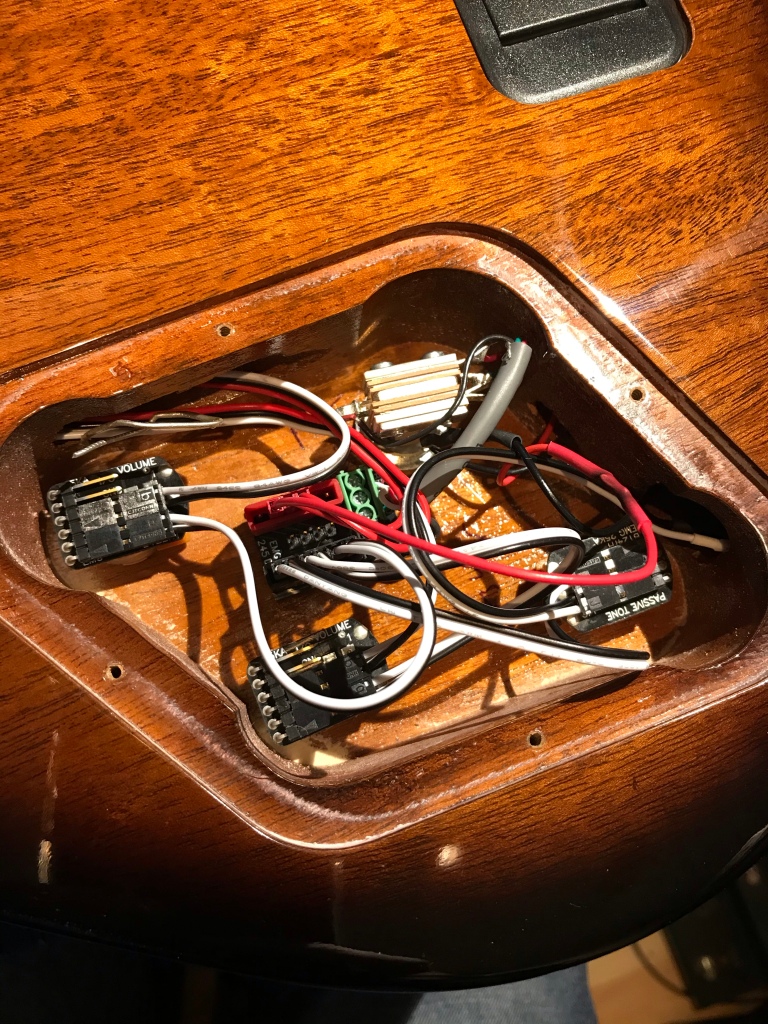Well I have finally settled on my preferred guitar tone. I don’t mean my ‘whole’ tone but instead the guitars themselves. Putting this post into perspective is important. I have played many different guitars. I have not played as many as I would like, but I have years to do that! During the course of finding pickups on electric guitars, I have always stayed close to my love of humbuckers. The style of music I like is classic 70’s and 80’s hard rock and metal. I obviously go out of that zone many times but always stay true to my heart.
So what about pickups? They are important as they are the conduit that brings the finger expression of a guitar string into an amplifier. Some become very obsessive about this. I am not in that camp. The tone of a guitar comes from many elements. It is affected by body plus neck wood, nut material, bridges, tone pots, construction and even temperature. A player could, and some do, go into the fine minutia of tone with guitars. Personally I love to see others doing this but I tend to change basics and go from there. Playing is individual, it is fun to try guitars and see which fit you as a player. Then if you’re not happy with the guitar tone then pickups and tone pots can make a major difference. One area I have no interest in is trying to create guitars of yesteryear. I understand why players love this area but body relics and replacing electronics with replica or original rare pieces is not my bag. I would rather have the old guitar but that market is very expensive. Even then I am not that interested in this area. I do like the history of guitars and as mentioned before, I like seeing others alter and buy vintage instruments and get a kick from their love of it.
Just a disclaimer, this article is not really about how many winds of wire and which strength magnet is used. In other words, it is not technical. There are some great write ups out there, not to mention to top YouTubers who really describe this area in interesting detail. This is about me chasing my tone and where ears and music passions converge though my favourite instrument.
So lets see the pickups in some of my guitars and why I like them

P90 
EMG 66/57 
Gibson Burstbuckers 
EMG 66/57 
Gibson GEM (EMGs) 
GS Handwound 
Fishman Modern 
Jaydee Hooligans
So there is quite a varied selection of pickup. Each has its own distinct style but I have, over many years, gone back to my love of active humbuckers. I started with putting a set of original black 81/85 EMGs in my Gibson Les Paul 18 years ago. My pick up choice came from the live music I have a long term passion for. Those first active pick ups came from a Zakk Wylde pack and I could only get them from America at the time. The problem was that they were missing something, on high gain they were superb. Quite articulate yet that great aggression but were slightly sterile on lower volumes. I swapped the pair over, neck to bridge and that was much better. The difference, I think was the due to the Ceramic and Alnico 5 variation. Now years later I want to try them again as new amp technology can help as pushing high volumes used to be a considerable problem. This is much easier now as the Universal Audio Ox Box and Boss Tube Expander can reduce the volume to manageable levels. Lunch box amplifiers help by reducing the need to use a master volume 100w monster.

UA Ox Box and Waza Tube Expander have helped keep large amps going without sacrificing tone
EMGs took a back seat for a while. I then put a Slash pair of Seymour Duncans in the Les Paul. I later bought a Marshall AFD100 that had the great Appetite for Destruction album tone. It also had an extremely versatile attenuator built in. With those Seymour Duncans and Celestion V30/GH12H anniversary speakers I had so much fun. In fact they were my favourite pickups for years. The output was high but not extreme. They have a great hard rock and blues sound. One of my favourite Guns and Roses songs is Nightrain and I nailed that tone. I took the pickups out but, like all my pickups, I keep them just in case I decide to regain that sound.
So what happened next? Well I stayed with passive pups. I already had a Jaydee SG with hand wound hooligans. I still love those pickups, especially in that guitar as it is a distortion that is pure Black Sabbath. They are silent, more so than any Gibson passive humbucker, yet are high output with a lovely warm neck sound.

Jaydee Hooligans
As for more passives I have 3 different types that have now been my mainstays. First I like the Gibson Burstbucker 3 and 2s. Both are in a Flying V (one of my top guitar styles) I tried them and really loved their aggressive attack. They have a classic Gibson tone that, together with a high gain amp, just creates pure metal. Again these are silent but the Burstbucker 3 can be overwhelmed when cracked, feedback city. This is always fun though and is part of the character for me. They can sustain for days. My Gibson Flying V seems to be very good as the playability is fast and notes just sing. I love it and those vintage burstbuckers will be my number one PAFs for a long time.

Burstbucker 2 and 3 mean sustain and classic metal
Well what can I say about the next passive humbuckers. I have posted about Gordon Smith in the past. They are the UK’s longest running guitar manufacturer, going since 1974. I have two of their superb guitars. The first is a custom built GS Graduate with hand wounds. It is all mahogany with an ebony board. The pickups are split-able and are very versatile to all styles. They are perfect for blues, rock and metal. Being wound on the original machine means they seem very consistant. There is smooth distortion and the adaptable nature of the humbuckers means the guitar is perfect for live use. Those pickups are really quiet, it is a treat to play. Gordon Smith really make great exceptionally built guitars.

GS Humbuckers, superb with all styles
I bought another Gordon Smith as I was not happy with the quality of the Gibson Les Paul Juniors I had seen and played. The answer was to ask Gordon Smith to build a GS1 with a P90. I wanted it to be mahogany with an ebony fret board with a natural finish. It was the GS1 that fuelled the punk movement so had a great heritage. Being unsure of the GS P90, I knew I could change it out if needed. The GS P90 was just spot on though. It is again versatile, and, for me has a richer tone than the Gibson. Obviously the guitar itself is quality in build and quality. That P90, although obviously not silent, can play hard rock and metal. ‘Metal’ – you ask, well yes it does. Not like a humbucker but it has a real hard rock distortion. I like the P90s more than single coils as they are a halfway house between both pickup types. I have played Lace single coils and did find them surprising and I like the Dave Murray signature pickups. In fact some great metal bands play single coils, Iron Maiden being the most well known. One day I may get into them, Rory Gallagher, Jimi Hendrix, Richie Blackmore and the great David Gilmour are just some of the many single coil players that changed the musical landscape. P90s for now though!

P90 in the Gordon Smith GS1
Time to get to the humbuckers I that have it all for me. Those active designs. I really did go full circle and end back at the beginning of the journey. Those 81/85 Emgs were never bettered when it came to my musical taste. The tone and warmth could be certainly bettered but the aggression and articulation were all there. So where does one go when searching for that elusive active sound. I have quite a few amps to play through so have all types of gain and sound options. Recently I am using a Kemper more than the live amps. I do like the Kemper Kone option too. This is where the choice of speaker can be changed which sounds great with mergerd or DI profiles. I still go back to valve amps for testing pickups though. It is my belief that the Axe FX and Kemper can get so close to the original tone that the interaction can only be differentiated at high volumes. Most live touring bands use alternatives to valve amps though. Mainly for convenience and for a front of house mix. I know Judas Priest still use valve amps, as will many others. On the other hand Metallica turned to Axe FX a while back. Their shows can be vast and they stated the need for consistency.
For me, Black Sabbath are the pinnacle of sound when it comes to hard rock. The Tony Iommi matchless sounds always came from Laney amps and that great touch on low gauge strings. He developed the pickups himself in order to tame the old master volume amps. Her continued that high gain sound, riding the volume, thought most of his live shows. I once heard them live in 2005 at Donnington and ‘into the void’ plus ‘electric funeral’ were incredible. Dark, grinding and uncompromising. That was really a basic set up. The humbuckers were a mayor park of that. Those Jaydee Hooligans come from the same luthier and with the two Laney amps, both Iommi based, are cranked, it is a sound that can stir the bowls of hell!
Let me get back to those active pickups. There are two main camps at the moment. I am in both. There is EMG and Fishman. Let us start with my verdict on the Fishman Fluence Moderns. When I got back into actives I chose both Emg and Fishman at the same time. My reason was due to trying some Fishmans out and finding the tone so different that I had to have both weapons in my arsenal. Fishman moderns have multi voice selection, which I prefer to coil tapping. The voices are different but not too far apart that they sound like totally different pickups. It is more than just aggressive and non aggressive. They go from a warm chug to a real monster metal quality tone. The clarity is fabulous, totally addictive. They clean up perfectly for me and the neck sounds organic but with the nature of an active humbucker. The moderns are ceramic and Alnico. I love that combination in actives. I also like the way the volume and tone pots are always very practical in their linear nature. I always miss that when going back to passives. It is like being plugged directly into the pickup. Yep, Fishman Fluence moderns have a very different voice to EMGs. EMG has the market share of different voiced combinations. They have been around since 1981 and now EMG s literally just plug and play with their pickups.

Fishman Fluence Moderns with that great Everyone bridge. Hit those strings as hard as you want and tuning is 100% stable, game changer
Here we are now with my favourites…..EMG. I went round those houses like I did in reality looking for my prime sound. I was watching a Judas Priest gig on Youtube and thought that the sound the guitarist, Richie Faulkner, was using reminded me of pure metal. It was as much a revelation, for me, as hearing Iommi’s tone (and many others too vast in scope to mention) Firstly, it was a Flying V, always we be my best after a Gibson RD. Secondly the pickups were EMG. I knew Glen Tipton wand KK used to be EMG users. It was this set of pickups Faulkner was using that seemed to catch me attention. Obviously he is a top player, the UK Zakk Wylde, and influenced by the same 70s and 80’s rock and metal I have been. I am no Richie Faulkner though, I can assure you of that!
So what was the sound that drew me in. Well it was definitely that EMG unimistakable sound. I real tight rhythm but without any sterile shrill tone. I almost instantly found out it was a combination of 57 in the bridge and 66 at the neck. The head was saying ‘but it is active, I have gone there and moved on’ I just had to take it that the riff bulletproof power would come from that set to start. I noticed when watching more videos of the 57/66 set that the 66 was warm and a perfect neck tone in my opinion.
I did have an active set in my collection. As I like Gibson RDs, I bought the 40th anniversary model was active ‘GEMs’ These are Gibson’s version of EMG. People online have been critical of them but I really liked them. I think Gibson got the affect they were after using PAF wiring and making them active to for silence and gain. I think it is no coincidence that GEM is an anagram of EMG. I suspect they collaborated, although I can’t say that for certain. The GEM pickups were high output and warm but not the ‘solid’ tone I was actually wanting. Luck had it that the last of the Richie Faulkner signature Flying V’s were selling. I tried 2 and decided one would be just right if I adjusted it quite a bit. Once the action and Floyd was perfect to my liking I really tested those pickups. I used 3 valve amps, Kemper and pedals for gain. They did not disappoint. What really helped was that the Faulkner V only has one volume pot and not tone. It also had an ebony board, my favourite fret wood. Yes, the 57 could play metal and more, the 66 was nice and warm but aggressive when needed. Both together was a new tone, perfect for blues. Mind you, the bridge position is a great blues tone when the volume is turned down or an equivalent amp is paired up.

The Richie Faulkner Flying V and those ‘I’m back’ EMG 57/66 humbuckers 
The Gibson RD and the controversial GEM PAF actives
I installed the same set in my Gibson Les Paul. I was used to soldering pickups but the set was ‘solderless’ Although I obviously used an iron while taking the old ones apart. I also soldered a few other bits together just to make sure it was connected solidly. I really do like that combination. I took the Seymour Duncans out and put the 57/66 in. Suddenly it is being played much more. That EMG set is not just metal, that Les Paul is a fine example of that.

EMG 57/66 installed in the Les Paul. Now a different and, for me, preferred tonal variety
Where next? Well I have found it in a source I wasn’t expecting. It was quite recent too. I have kept the 57/66 combo. That will not being going anywhere soon. It is getting good use. The new EMG set? The story is unexpected, for me! It was during Covid 19 lockdown. On YouTube, Metallica, where showing fundraising concerts from their past and also some recent gigs too. Now I have not been paying too much attention to the band. Death Magnetic was the last album I had by the band. I still respected them but last saw them in 2014 when the BBC showed their headline set at Glastonbury. No doubt one of the top live metal bands ever if not one of the top live bands in general. They certainly give value for money with Shows lasting 2 hours plus. I had mostly kept up with the guitarist, Kirk Hammetts collection and enthusiasm for horror. That all changed when, together with a decent TV sound system, I heard some great guitar sounds. I had to go through a few shows to hear them played through valves. The band have such large stages that their sound is now Fractal Axe-FX. They need that consistency live and it does sound superb. With their huge back catalogue of music, no wonder they have gone in that direction.
What I heard were a very versatile set of EMGs. Metallica’s James Hetfield and Kirk Hammett have played EMGs as soon as they could. That original sound defined thrash. Other bands used them to tame that loud fast and aggressive wall of sound. There were other trailblazers like Anthrax with Scott Ian who used mostly passives. Not everyone in metal uses actives. From rock in the 70’s to bands such as those connected to the NWOBHM we saw pick ups such as the iconic DiMarzio Super Distortion and a host of Seymour Duncan high output passives. I have played a Guitar with Super Distortions installed and they reminded me of that great early 80’s sound. I remember it being very hard to control feedback and riding the volume but they were great. So much character and a wonderful combination with a cranked JMP. Mine was being played through a modded 2203 JCM and It was so much fun. It is in my list of pickups to get but that is another story for another blog!
When I have watched Slayer live, many years ago, and it was a small venue. The place was shaking with how loud the stage amps were. I remember there being no PA. Through those Marshall JCMs you could hear every note. Deafening though it was, I can tell you it was a chest pounding experience. That was possible with EMGs through those fierce monsters.
I wanted to take the Gibson GEMs out of the RD and so I tried to get hold of a James Hetfield set of EMGs. Due to lockdown and stores just opening it was very hard to get hold of a set. Not to mention a set of Gold ones to match the guitar hardware. In a way the JH HET set do have a similarity to the GEMs. Both are a blend of passive and active. More than 81/85s or my favoured 57/66 set. The GEMs just don’t have enough aggression for me. The only problem was that, due to lockdown again, I had not played a guitar with those HET sets installed. I was only going off what my ear was saying and the reason they seemed to be developed. Reviewers seemed to agree the dual feeling was there with no real compromise. Surely this could not be true?
In the end I went to that great Thomann online store and trusted them to be able to bring some in from the supplier in a couple of weeks. They did not disappoint as ususal. All the way from Germany in good time. Let’s look at the install.

Inside before replacing. Note Gibson using circuit boards. Great for removing but why? Although one could say the RD was originally a development model, although that is stretching it!

Gem pick up backs. I will keep them with the guitar, or may use them in the another model in the future as I think they are fine

New EMG JH Pots and jack connected. Battery cavity soldered. The instructions with the set seem to be incorrect regarding the connections with the volume pots. It took me hours to work it out. They are different to this photograph. Plugs should be to the left exposed pins instead. No idea the reason the schematic is wrong
The result? These really do deliver. Pick hard and you get a high gain attack, perfect for downpicking and chugging. Give them a light touch and the passive colour comes to the fore. The Neck is warm and articulate, volume slightly down and chords shimmer with a PAF palette. All along they have active silence. Everything you give them as a player is fed back. More than any active set I have tried before. I even think the Gibson RD was luckily the best guitar I could have employed them in. The sustain rings for miles and when down tuned the EMGs feed satan’s own horses as they spit out huge low end with midrange balance. Never once over stepping with gain. I even tried them on a ENGL Powerball 2 I have. It has four channels but it was left on lower gain and the picking style, guitar volume and attack does it all (as should always be the case with the best pick ups)
Downsides? I have to be honest and say none at all. Maybe priced higher than needed but they do have a signature name so it can be overlooked. Trying the set on a one channel Laney LA30BL with a Ti Boost and a matching cab created as much as you distoration fed in. I even got a perfect blues tone and added some reverb. The HET set suddenly sounded like a rich invigorting humbucker. Then turn the amp up together with the volume pot on the guitar. They become monstrous. All I can say is that my belief is on the seventh day God didn’t rest but instead created active pick ups for those who want their souls stirred.








